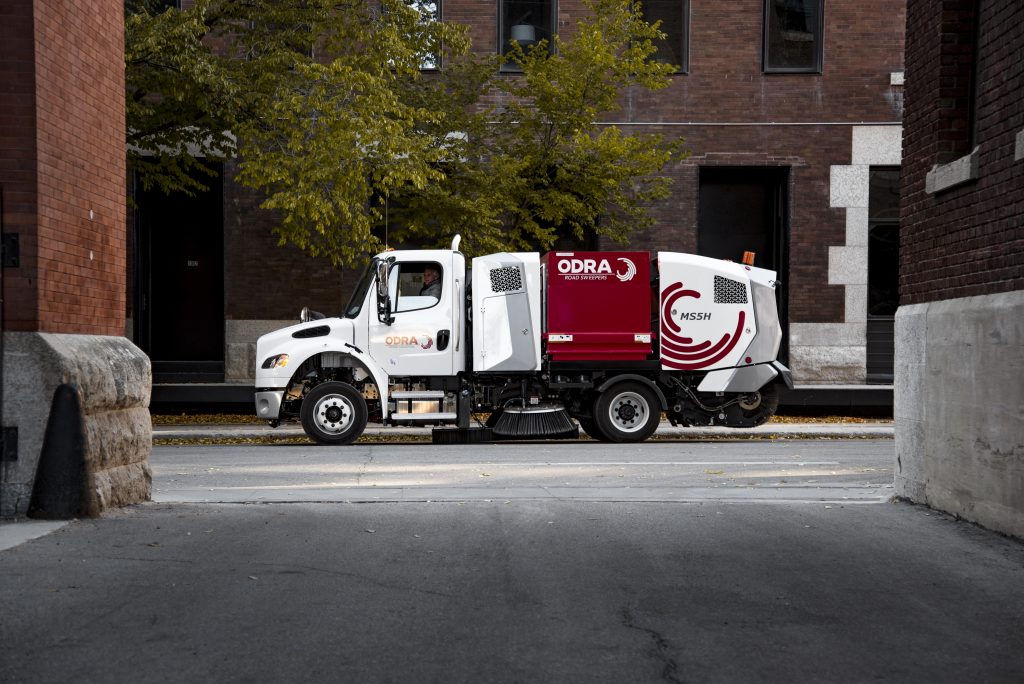As fall arrives, road sweepers across North America prepare for winter downtime. Proper storage isn’t just about parking the unit—it’s about taking proactive steps that prevent damage, extend equipment life, and save money when the busy spring season starts again. By following these essential practices, operators and fleet managers can avoid costly breakdowns and keep their sweepers performing at their best.
Thorough Cleaning
Cleaning may seem simple, but it is the foundation of successful storage. Dirt, leaves, and debris hold moisture, which can accelerate rust and corrosion if left inside the hopper or on critical components. Likewise, leftover material in the water tank or spray system can freeze and cause cracks.
HOW: Remove all debris from the hopper, conveyor, and brushes. Rinse down the interior, making sure no residue is left behind. Drain the water tank and flush the system. Don’t forget to clean underbody areas where salt or chemicals may have built up. To prevent the spray system from freezing, add two gallons of Windshield Washer Fluid or RV Antifreeze to the tank, then run the spray bar pump until nozzle fluid changes color to match the fluid used. Consider a pet-friendly kind for our furry friends.
WHY: A clean sweeper avoids corrosion, prevents freeze-related damage, and ensures fewer start-up problems when the unit is put back to work.
Inspection
Winter downtime is the perfect opportunity to give your sweeper a detailed inspection. Small issues caught now can save major costs later. Focus on high-use parts that endure the most wear.
HOW: Inspect belts, hydraulic lines, and electrical connections for wear or leaks. Check broom bristles, skirts, and seals, replacing any that show significant wear. Look for rust spots on metal surfaces and treat them before storage.
WHY: Addressing problems before winter ensures the machine is ready in spring. Neglecting inspection can result in breakdowns, delays, and expensive repairs during peak sweeping season.
Lubricate Moving Parts
Idle machines are more prone to rust, and lubricants can dry out over long storage periods. Giving moving parts proper attention ensures smooth operation when the sweeper is back in use.
HOW: Grease all bearings, chains, and pivot points according to the manufacturer’s maintenance guide. Use the recommended lubricants for your machine to maximize protection.
WHY: Proper lubrication prevents parts from seizing or corroding over winter. This reduces wear, extends the lifespan of moving parts, and lowers maintenance costs.
Ensure Smooth Operation
By taking time to perform these steps now, you set your sweeper up for reliable use in the spring. A machine that has been cleaned, inspected, and lubricated will return to service quickly, reducing downtime. Preparation today means fewer headaches tomorrow and more confidence that your equipment will be ready when contracts and projects pick up again.
The Cost of Inaction
Ignoring preventative maintenance can quickly turn into expensive repairs. Worse, it can take sweepers out of service during the busy season when uptime is most critical. Failing to prepare leads to frozen tanks, corroded components, seized bearings, and frustrated operators. Most importantly, downtime in spring means missed contracts, delayed projects, and ultimately revenue loss.
Why Choose ODRA?
While all sweepers require proper care, not all are built the same. ODRA Sweepers are designed with durability, efficiency, and operator convenience in mind. Features like heavy-duty steel construction, simplified maintenance points, fuel-efficient design, and intuitive controls mean less downtime, lower total cost of ownership, and greater reliability. One standout feature is our use of lubricant-free pin and bushing systems at all pivot points—eliminating the need for daily greasing and reducing overall maintenance time. For contractors and municipalities across North America, ODRA is a trusted partner in keeping roads clean and fleets running smoothly. To learn more about ODRA Road Sweepers, visit us at www.odrasweeper.com/magazine

